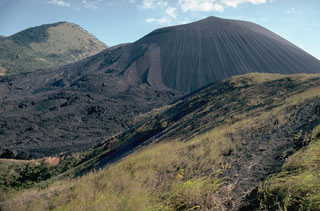Report on Cerro Negro (Nicaragua) — February 1980
Scientific Event Alert Network Bulletin, vol. 5, no. 2 (February 1980)
Managing Editor: David Squires.
Cerro Negro (Nicaragua) Fumaroles generate small white plume
Please cite this report as:
Global Volcanism Program, 1980. Report on Cerro Negro (Nicaragua) (Squires, D., ed.). Scientific Event Alert Network Bulletin, 5:2. Smithsonian Institution. https://doi.org/10.5479/si.GVP.SEAN198002-344070
Cerro Negro
Nicaragua
12.506°N, 86.702°W; summit elev. 728 m
All times are local (unless otherwise noted)
A small white plume formed by several small fumaroles was visible from the air in early February 1980.
Geological Summary. Nicaragua's youngest volcano, Cerro Negro, was created following an eruption that began in April 1850 about 2 km NW of the summit of Las Pilas volcano. It is the largest, southernmost, and most recent of a group of four youthful cinder cones constructed along a NNW-SSE-trending line in the central Marrabios Range. Strombolian-to-subplinian eruptions at intervals of a few years to several decades have constructed a roughly 250-m-high basaltic cone and an associated lava field constrained by topography to extend primarily NE and SW. Cone and crater morphology have varied significantly during its short eruptive history. Although it lies in a relatively unpopulated area, occasional heavy ashfalls have damaged crops and buildings.
Information Contacts: R. Stoiber, S. Williams, and M. Bruzga, Dartmouth College.

